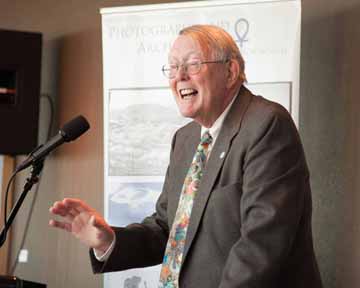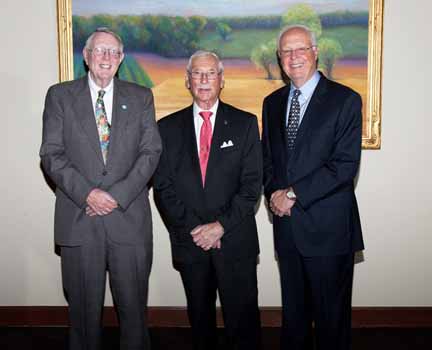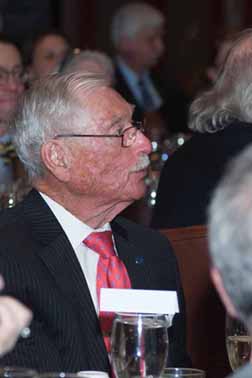
P. E. MACALLISTER AND ASOR
Remarks by Eric M. Meyers at the Gala Dinner Announcing the Establishment of The P.E. MacAllister Endowed Scholarship Fund For Archaeological Volunteers
When we think of what has happened in the Middle East these past 40
P.E.’s enthusiasm for history and archaeology is infectious and all of us who have listened to him on the Board when he spoke of historical episodes from which he could draw a parallel that would resonate with ASOR‘s present concerns, we all took pride in his words and wished our best students could have heard P.E. hold forth. His use of historical analogy has provided all of us in ASOR with a valuable pedagogical tool that is helpful in the classroom and in our not-for-profit work. Because ASOR’s mission is to explore the past and present it to the public and P.E.’s passion for that subject overlapped so well, we were a perfect match, ASOR and P.E. MacAllister. All the chaos of Middle East politics and unrest could not detract from ASOR’s quest to uncover from the ancient past in the Near East the secrets long buried underground that might help us better understand the present, and not just in that region but worldwide. P.E. guided us through those years with a steady hand and a singular purpose and ASOR not only survived but prospered in those challenging years. While ASOR, which was founded in 1900, was once a unified single entity with programs in different countries, first Palestine, then Iraq, and so on, ultimately wars and local politics forced a unified ASOR to reorganize and take those differences into consideration and somehow redefine itself in relation to the overseas institutes in a new way. P.E. and I as president alongside him, were a part of that process and P.E.’s business acumen, common sense, and historical insights enabled ASOR to get through a very difficult period in its history. ASOR ceded the Jerusalem property to the Albright, weaned the overseas institutes from its annual subventions, and redefined ASOR so that it became what it is today, the preeminent society for sponsoring American archaeological excavations and surveys, for promoting scholarship in the basic languages, cultural histories and traditions of the Near Eastern world, and outlet for the timely dissemination of research results in Near Eastern studies disciplines in published form and on the web.
Let me tell just one story to illustrate what sort of man
Well when those digital images arrived I called Rachel Hallote my colleague in archives and told her about it and we tentatively identified them as the missing negatives of the first photographic expedition of the American Palestine Exploration Society, ASOR’s predecessor organization founded in the 1870’s and conducted in the year 1875—the rest of the negatives were in the possession of the Palestine Exploration Fund in London. The photographer was Trancrede Dumas of Beirut who was accompanied by Americans throughout the photographic journey. I had a sense of what these photos were worth, and I called P.E., at that time Chairman of the Board. As it turned out P.E. was in Florida, and he knew the retirement community. P.E. said that he would drive over and have a look at them. Next thing I knew, ASOR was in possession of this priceless collection of photographs, which were restored under the NEH grant and mounted on the web; and most recently they have been published by ASOR in an Annual in 2012 along with the PEF photos to complete the collection, and the volume is dedicated to P.E. MacAllister. This collection of photos supplements rather nicely the original permit or “firman” of the first APES expedition in 1873 to Palestine and signed by the Ottoman Sultan and ornately decorated and written in Turkish language in Arabic script, discovered as part of the ASOR archive project at the Harvard Semitic museum. This large item is now hanging in the ASOR offices in Boston on the BU campus and has been restored and replicas made under the same NEH grant. This rare group of holdings is just one of many examples I could provide of how P.E. has allowed ASOR to do the right thing and prosper with his generosity and wisdom.
So as we progress now in hearing a series of testimonials in P.E.’s honor let us all think about what we have learned from him, from his words written or spoken, or by his example in the many causes that he has supported. Herodotus the Greek historian, who is known as the “father of history,” was also known for his love of life and broad-mindedness. He believed that Greeks could learn a lot from the people around them, and so Herodotus wrote about many other cultures, some of which he also visited, such as the Egyptians and the Scythians. He wrote a great deal and a few lines of his remind me of the person we honor tonight: “The only good is knowledge, and the only evil is ignorance.” He also wrote: “The most hateful human misfortune is for a wise man to have no influence.” We in ASOR have been fortunate to have had P.E. MacAllister influence our work for decades, and we will never forget him.
Toast to P.E. MacAllister made by Eric M. Meyers
After all the accolades and speeches, all of us surely get the message that history 
“To remain ignorant of things that happened before you is to remain a child.”
That is the essence of the man MacAllister, and that is the essence of ASOR which for 113 years has been bringing to the fore the lessons of the ancient and modern Middle East: birthplace of writing, birthplace of science and astronomy, birthplace of urbanism, birthplace of law, birthplace of three Abrahamic religions, and region of untold numbers of some of the most important architectural monuments of the past, many now in danger of destruction by war. We salute our chair for all the wisdom and generosity he has shown to ASOR and so many others.
Robert Browning wrote in his famous poem in honor of the famed rabbi of the 12th century who was a poet, mathematician, astronomer, and renowned grammarian of Hebrew, Rabbi Ben Ezra:
“Grow old along with me, the best is yet to be, the last of life for which the first was
made…Our times are in His (God’s) hand.”
We raise our glasses to P.E. and say after me: “May you live to be as old as Moses!”
The above remarks and toast were given by Eric M. Meyers
April 20, 2013
Skyline Club, Indianapolis, Indiana
On the occassion of the ASOR gala dinner honoring P. E. MacAllister
Tabula Honorarium of Donors to the MacAllister Endowment
News Summary of the MacAllister Gala Event
Photo Gallery of Images from the MacAllister Gala Event
Mr. MacAllister’s “An ASOR Validiction” Address to the ASOR Board of Trustees